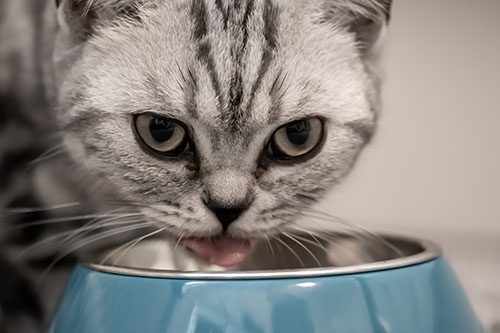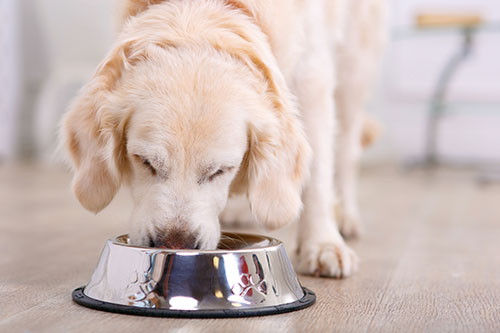Nutritional Therapy
“The food you eat can either be the safest and most powerful form of medicine or the slowest form of poison” – Ann Wigmore

Nutrition is the foundation of health; without good nutrition, good health is very difficult to attain. Our pets eat what we give them, and they depend on us to make good decisions. Our pets lives are a reflection of our lives, only they live a much shorter life-span, so we see the effects of our choices much sooner. If we choose to eat poorly and not exercise, most likely our pets are having similar issues.
What happened to pet food?
The dilemma with pet food, is that it is designed for convenience. Few of us are old enough to remember when our dogs ate our dinner scraps, but pets thrived for years eating this way. Then, with the industrial revolution, food had to be produced in mass quantities and had to be preserved in cans so it would stay fresh. Consumers switched from eating whole foods to eating preserved foods and also wanted the same convenience for their pets, so canned pet food was produced. When metal was rationed in World War II, dry food (kibble) was invented.
Dry food is made through the process of extrusion, which requires very high temperatures and results in degradation of nutrients. In addition, high levels of carbohydrates are required to make the kibble uniform. The end result if that we have plenty of readily available processed food with less than ideal nutritional content both for ourselves and our pets.
Although pet food is regulated by several government agencies in the U.S., regulations are mostly concerned with false labeling, contaminants that may pose a safety threat and meeting minimum nutritional requirements to allow them to be labeled “complete and balanced”.
As long as there is a demand for pet food that is cheap and easy to feed, pet food companies will continue to fill the shelves. Convenience is everything in our society and more often than not, healthy food is less convenient.
Many times, diseases in Western society tend to be diseases of nutritional excess. For example, diets high in carbohydrates can lead to insulin resistance and diabetes in cats and people. The proper balance of vitamins, minerals, and nutrients and slow down (and sometimes reverse) the course of various diseases. Some diseases, such as diabetes in cats can be completely reversed with diet changes alone.
Intuitively, everyone can agree that eating a fresh, whole-food diet is healthier for us and our pets; however, there may be higher costs associated with this form of eating and perhaps a sacrifice of some convenience. You have to decide how important good nutrition is and if it is worth the slightly higher cost and inconvenience. In the long run, money spent on good food, is less money spent at the doctor’s or vet’s office!

Why do we know so little about nutrition?
Part of the problem is your veterinarian. Yes, I’m blaming myself and my colleagues! When was the last time you had a great discussion about your pet’s diet with your veterinarian? Nutritional advice is often left in the hands of people with little to no formal training about nutrition or worse yet to Dr. Google.
You should not feel embarrassed to confront your veterinarian about what to feed your pet. It is our job to provide that advice. The ultimate goal is the creation of a health care plan that focuses on prevention as much as on the treatment of disease and the cornerstone of this new paradigm is nutrition!
Quick Reference Guide to Nutrition:
Here is a quick reference guide for optimal nutrition taken from The Ultimate Pet Health Guide, Gary Richter MS DVM. By the way, this is a fabulous book about optimal pet nutrition written for the pet owner but full of technical information.
Water:
- Access to fresh, clean water is vital to good nutrition. Consider circulating water fountains for cats.
- Clean water is imperative. Have your water tested and get a filtration system if needed.
- Switch to foods with higher moisture content. Fresh, whole food diets and canned diets have a much higher content of water.
Protein:
- Protein in dog and cat food should be from meat sources, not from plant based products such as soy, gluten, or other grain-based proteins.
- Look for whole meat products, not meat by-products or meat meals.
- Aim for higher levels of proteins, unless otherwise directed by your veterinarian. Fresh foods and higher quality pet foods tend to have higher protein levels.
- Calculate protein on a dry matter basis. Buy the book to figure out how to do this.
Fats:
- Essential Fatty Acids (EFAs) are fats that the body cannot make and need to be supplemented in the diet. These are otherwise known as omega 3’s and omega 6’s. Omega 3’s are primarily found in fish products; while omega 6’s are present in plants and are plentiful in food. Omega 3’s need to be supplemented. Consult with your veterinarian to figure out the amount.
- Don’t assume all supplements are safe. Avoid supplements made from GMOs, farmed grain-fed fish, and conventionally raised farm animals.
- Feed fat responsibly. Too much can cause weight gain and gastrointestinal upset.
Carbohydrates:
- Not all carbohydrates are bad! Carbohydrates are found in plant material, fruit and grains. Pets can use carbohydrates for energy, and fiber is important for digestion.
- Pets should have low amounts of carbohydrates and excessive amounts lead to weight gain, inflammation and diseases such as diabetes.
- Commercial kibble (dry foods), even grain-free and low carb dry foods contain excessive carbohydrates because they are inexpensive and are necessary in the extrusion process to make dry food. Cut back on these foods or eliminate them if possible.

Vitamins and Minerals:
- Always use foods and recipes that are balanced by a qualified nutritionist.
- Over-supplementing can be just as dangerous as under-supplementing. Remember that cats have special needs and cannot eat dog food.
- If your pet is eating a well-balanced, nutritious diet, there may be no need to supplement but always check with your veterinarian.
Look at the labels on your pet food, take pictures or bring the bags/cans in when you visit us. Actually measure the amount you are feeding.
Dr. Woerner would love to help you figure out how to help your pet eat healthier and live longer with fewer illnesses and diseases.
